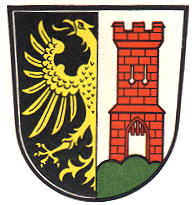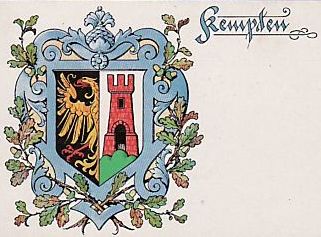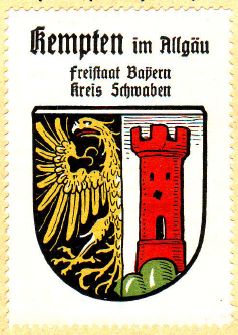Kempten
| Heraldry of the World Civic heraldry of Germany - Deutsche Wappen (Gemeindewappen/Kreiswappen) |
KEMPTEN
State : Bayern
Urban district (Stadtkreis) : Kempten
Additions : 1972 Sankt Lorenz, Sankt Mang
Official blazon
Gespalten; von Schwarz und Silber; vorne am Spalt ein halber goldener Adler, hinten auf grünem Dreiberg ein roter Zinnenturm mit offenem Tor.
Origin/meaning
The arms were officially granted on December 12, 1488 and confirmed on January 5, 1819.
Kempten was an Imperial city in medieval times and thus entitled to use the imperial eagle in its arms and seals. The oldest seals, however do not show the eagle. The oldest seal dates from 1379 and shows the patron saint of the city at the time, St. Gordianus, with a small shield. Later sources indicate that the shield was horizontally divided from silver and blue. The second seal dates from 1403 and shows St. Hildegard, who was combined with the arms in a later 15th century seal. In 1488 Emperor Friedrich III granted the city new arms, a vertically divided shield gold and black, with the imperial eagle in the opposite colours.
In the late 16th century the city started to use the symbols used on the local coins, an eagle with the letter K on its breast. These arms were used until 1819.
In 1818 the city was combined with the Imperial Abbey Kempten and the new arms showed the imperial eagle from the city arms, and a tower taken from the arms of the Abbey.
| The arms of Kempten as shown on a postcard from 1905 |
The arms in the Kaffee Hag albums +/- 1925 |
Contact and Support
Partners:
Your logo here ?
Contact us
© since 1995, Heraldry of the World, Ralf Hartemink 
Index of the site
Literature : Stadler, K. : Deutsche Wappen - Bundesrepublik Deutschland. Angelsachsen Verlag, 1964-1971, 8 volumes.













